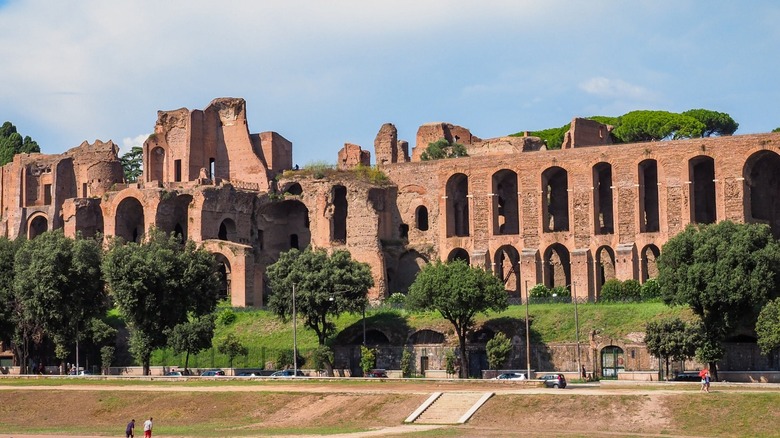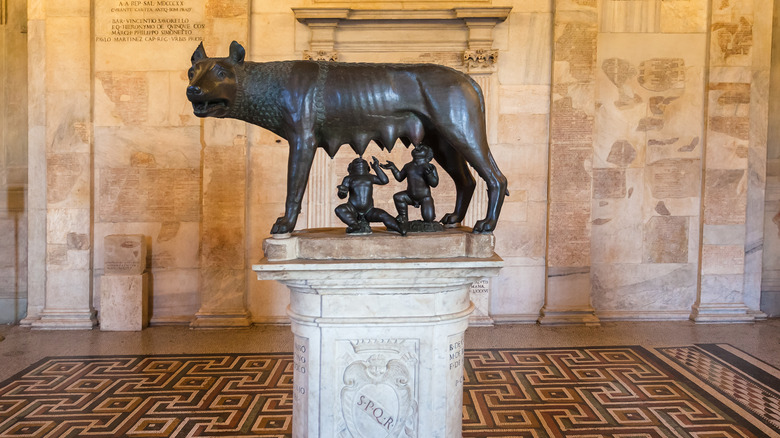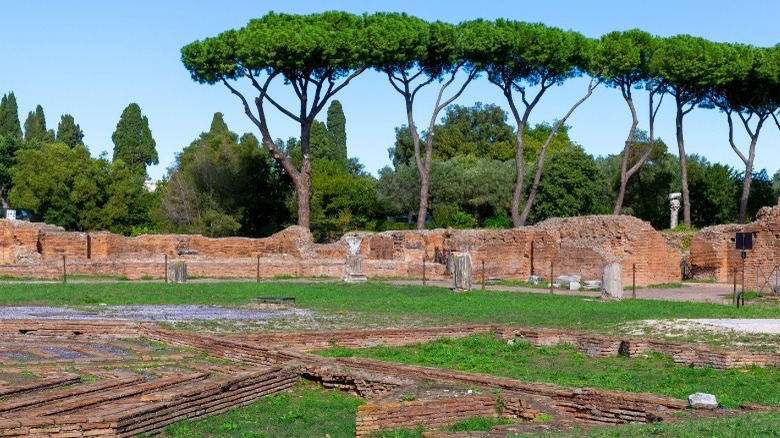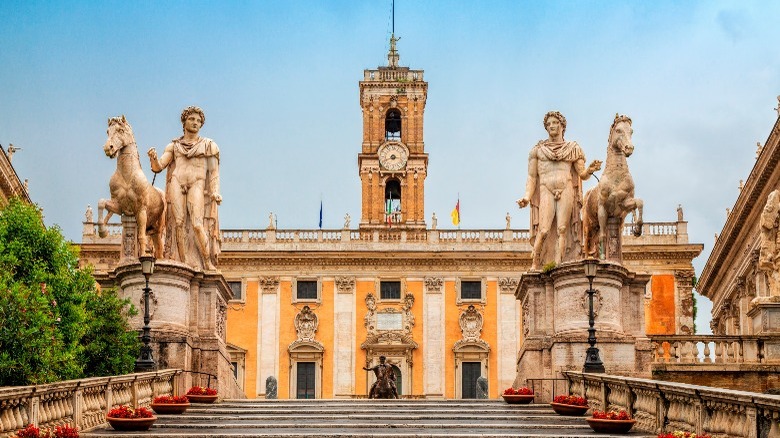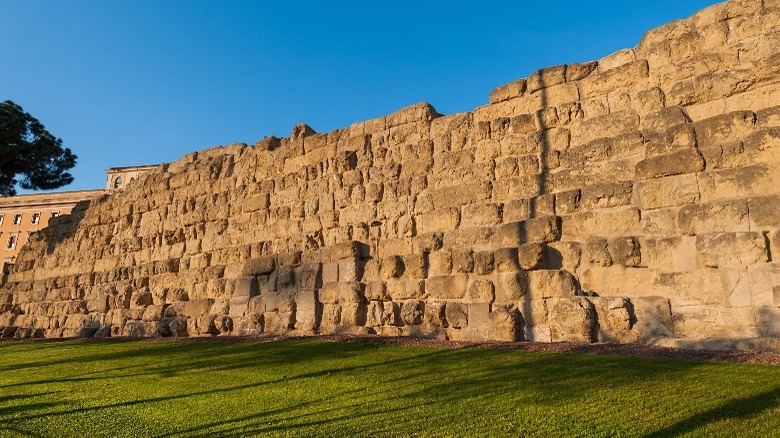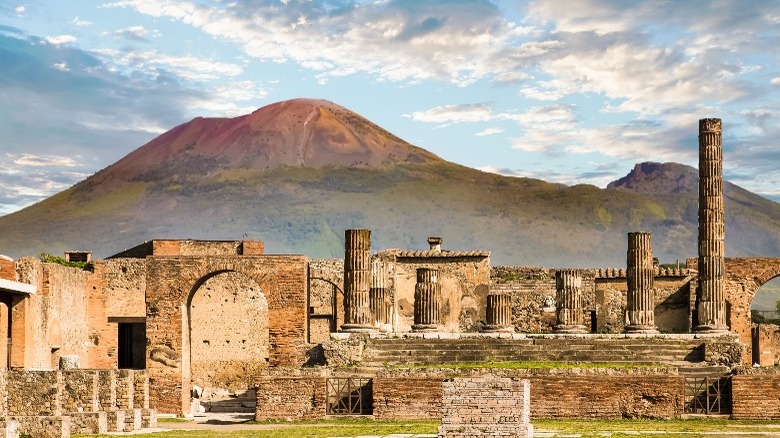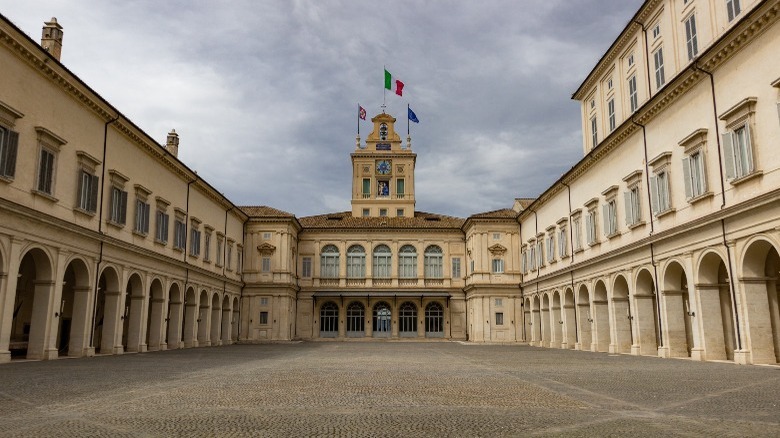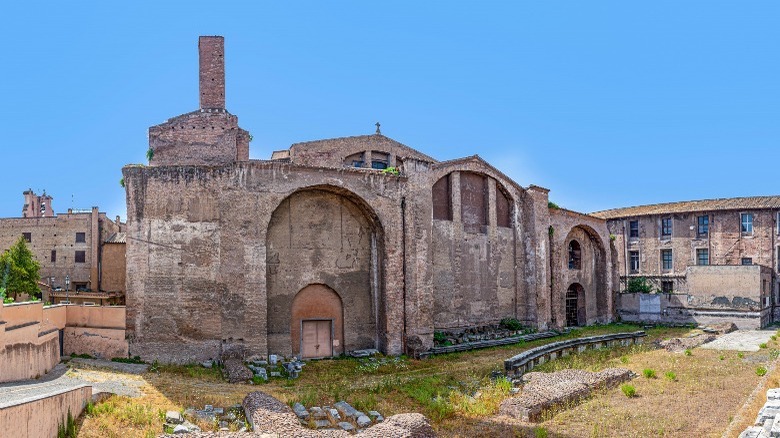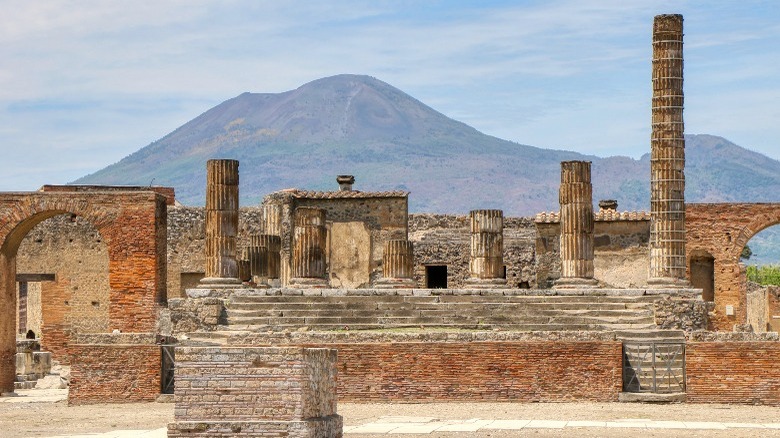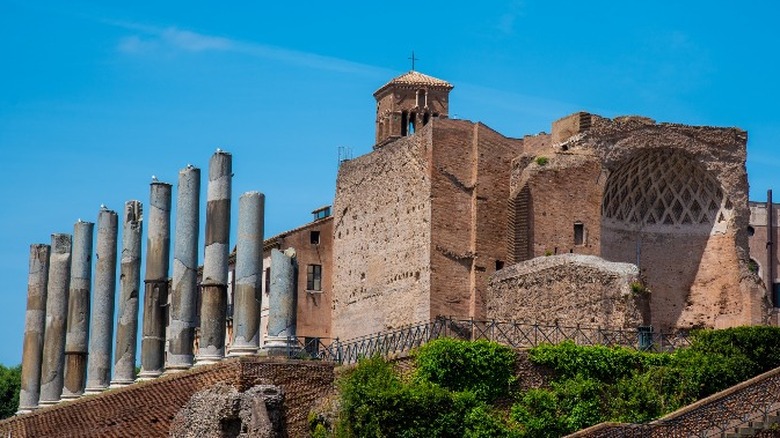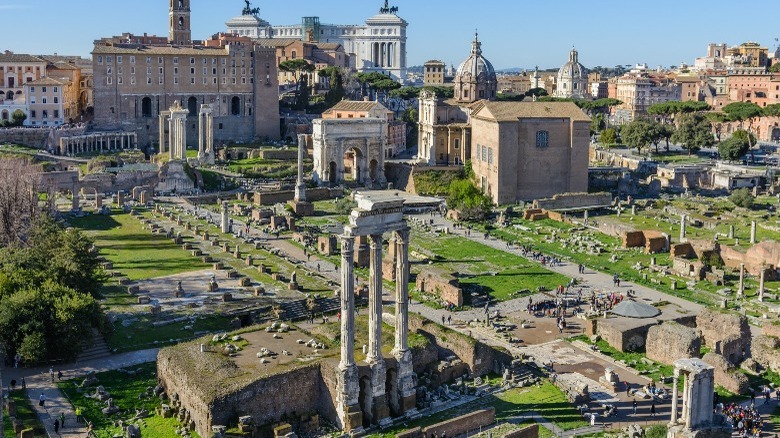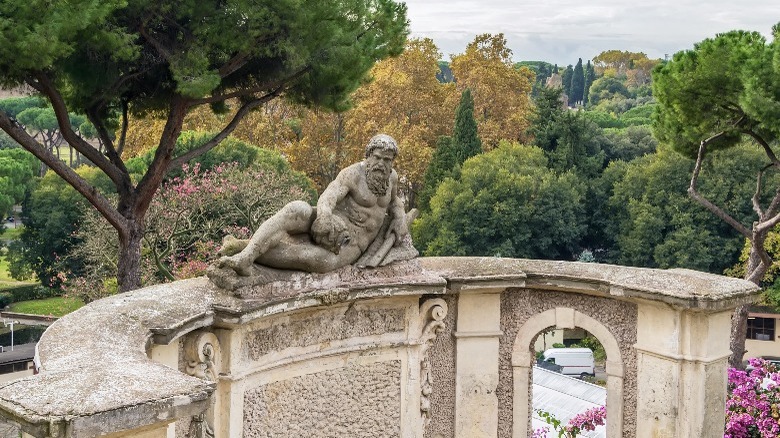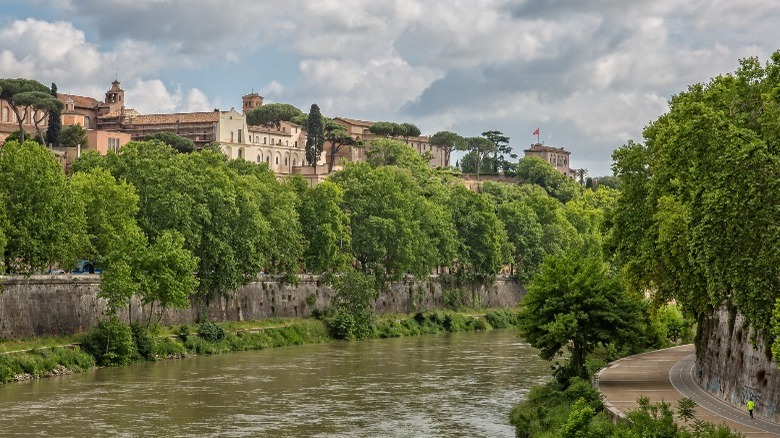The Seven Hills Of Ancient Rome Explained
Pretty much everyone has heard of the Ancient Romans. From Julius Caesar to Augustus, and from Nero to Constantine, the emperors of Ancient Rome have been written about so much, they're largely considered common knowledge at this point. Yet, one of the lesser written aspects of Ancient Rome is its collective seven hills. If you live in Rome, you undoubtedly know about them, but if you've never been to Rome, you probably haven't heard of them at all.
The seven hills of Rome are Palatine Hill, Capitoline Hill, Quirinal Hill, Viminal Hill, Esquiline Hill, Caelian Hill, and Aventine Hill. According to Italy Magazine, Palatine Hill is the oldest Roman settlement, dating back all the way to 753 B.C.E. — more than 2,700 years ago. For centuries since, the seven hills have all played important parts in Roman history, from housing emperors and temples, to being the site of massive ancient armies. These are the seven hills of Ancient Rome explained.
The seven hills are the foundation of Rome
While it's impossible to be precise about the beginning of the Roman Empire, there is textual evidence of the important role of the seven hills in the founding of Rome. According to Marcel Le Glay in "A History of Rome," there are two main textual sources for the origins of Rome — Greek and Latin authors. The Greek authors place the founding of Rome in what would be the 12th century B.C.E., whereas Latin authors instead date it to 754-753 B.C.E.
When writing about the founding of Rome, the Latin authors, like Fabius Pictor, wrote about the tale of twins Romulus and Remus, who were nursed by a mythical she-wolf creature (pictured above). Authors traditionally ascribe the founding of Rome to Romulus, who is said to have "founded a city on a hill."
As Italy Magazine explains, the hill Romulus founded Rome on was one of the seven hills: Palatine Hill. The other seven hills — Capitoline, Quirinal, Viminal, Esquiline, Caelian, and Aventine — were also the site of proto-Roman settlements. Initially, they were completely separate territories ruled by separate leaders. However, over time, they gradually coalesced together to form what would become Rome. The seven hills truly laid the foundation for Rome, and they were often the site of important monuments and buildings during the Roman Empire.
The seven hills and the Septimontium festival
The story of the founding of Rome on the seven hills became an important part of Roman lore. As Robert E.A. Palmer notes in "The Archaic Community of the Romans," the communities of the seven hills held an annual religious festival known as the Septimontium. The festival took place in mid-December, and according to the prolific Roman author Varro, it was a private rather than public festival. Mary Beard in "SPQR: A History of Ancient Rome" explains that Septimontium translates to "seven hills," and that at least one scholar speculates this could have been Rome's original name.
Interestingly, there were as many as eight hills involved in the Septimontium, which means it's possible something was lost in translation over the many centuries since it ended. The hills involved in the Septimontium were the Palatine, as well as the Velia, Fagutal, Subura, Cermalus, Oppian, Caelius, and Cispius — which were smaller hills that were part of the larger seven hills.
Most of them were part of the larger Esquiline Hill, including the Velia Cispius, Oppian, and Fagutal (per Amanda Claridge in "Rome: An Oxford Archeological History"). Today, much of the Septimontium festival is shrouded in mystery. It's clear that it was an important festival, but exactly what was being celebrated and why is not entirely known. It's possible with time more information will be discovered, but it could just be one of history's many mysteries.
Not everyone can agree on the seven hills
Even though the seven hills are traditionally known as the foundation of Rome, that doesn't mean that every Roman source has agreed about them. According to Amanda Claridge in "Rome: An Archaeological Guide," ancient Romans weren't always in agreement about which specific hills actually constituted the original seven. As Claridge argues, the fact that the Septimontium had eight instead of seven hills, and that four of the commonly understood seven hills — Capitoline, Aventine, Quirinal, and Viminal — were not listed as taking part, points to a pretty big discrepancy in the record.
Claridge further goes on to suggest that it's possible the hills we know as the seven hills were not actually recognized as such in ancient times. Evidence points to deliberate efforts by later Romans to create a list of seven hills that would coincide with the area where Rome was thought to have been originally formed. According to "The Seven Hills of Rome," even in official Roman government documents, the number of hills fluctuated between six and eight.
As Claridge further notes, much of the textual history we have on the archeology of the seven hills is questionable. There are many features, for example, that are recorded as existing by ancient Roman authors, but there's no physical evidence to support them. In fact, the hills Aventine and Quirinal can't even be seen today; most of our information on them relies on these records.
How the Servian Wall protected the seven hills
For early Roman communities on the seven hills, security was one of the most important aspects of their lives. According to Don Nardo in "Ancient Rome," some of the seven hills are thought to have had minor fortifications on them, made from natural resources like dirt. This, in combination with the steep slopes of the hills, is what some residents used to stop outside attacks. While this served as useful for a while, by the fourth century the city had decided on a more efficient tact.
Instead of building individual walls for each hill, in 378 B.C.E., the Romans started constructing what would become known as the Servian Wall. The Servian Wall was made of stone and went around the entire length of the city, encasing all seven hills, and there was a moat in front of it for increased protection.
As explained by Brendan D. Nagle in "Ancient Rome: A History, the Servian Wall was created following repeated attacks from Celtic warriors. An illustration of the wall shows how it snaked around each of the seven hills, and was connected to the Tiber River on the north side and Aventine Hill on the south. The wall was named after the Roman emperor Servius, who some sources indicate was the one responsible for constructing it (via "Ancient Rome: An Introductory History"). However, the modern consensus is that the wall was built after his reign, in the fourth century.
The seven hills' volcanic past
While the seven hills of Rome eventually became the site of one of the largest settlements in human history, it was not always a hospitable place for people. As "The Seven Hills of Rome: A Geological Tour of the Eternal City" explains, previously, the Alban Hills just south of the seven hills in Rome was the site of massive volcanoes. Somewhere between 550,000 and 350,000 years ago, there was a series of large volcanic eruptions near the seven hills. As a result, the entire area, including the seven hills, became choked with the volcanic ash and pumice that was blasted in all directions.
Not only did everything acquire a nice thick layer of dust, but all signs of life soon started to die out, too, as the ash and pumice killed the flora and fauna present in the area. Huge buildups of debris changed the direction and shape of large rivers, and also created a massive plateau made of tuff.
When further eruptions changed the path of the area's rivers, they cut through the tuff plateau in various directions, which is what formed the seven hills of Rome. Most of these rivers were just small tributaries that came from the Tiber River, which is located to the west of the hills. The hills themselves are actually pretty small but were big enough for communities of people to start settling on.
Quirinal Hill: the pope's summer palace
Historically, Quirinal Hill was one of the most important of the seven hills of Rome. According to "The Seven Hills of Rome," Quirinal Hill used to be the site of housing for some of the more wealthy Romans of the time. The Palazzo del Quirinale (pictured above) sits on the top of the hill and is actually where the president of Italy lives. Also on the hill are sculptures of Jupiter's twin sons Castor and Pollux, which are incredibly large and have been in place for more than 400 years.
Previously, until the mid-19th century, the pope lived in a palace on Quirinal Hill during the summers. That palace then housed the Italian royal family for more than seven decades, before the Italian presidents took it over in the 20th century. There also used to be the Acque Sallustiane springs located in the valley near Quirinal, but the area has changed since then and the springs are no longer visible. Apparently, the spring used to run through the Hotel Bristol Bernini's basement, located near the hill.
The Quirinal and the Viminal feature summits with flat tops, and largely consist of pyroclastic tuffs from earlier volcanic eruptions. The name Quirinal comes from the god of war Quirinus, originally a Sabine god before becoming associated with the Romans (per "Ancient Rome: An Introductory History"). Quirinal Hill, along with Viminal Hill, is the northernmost of the seven hills (via "Ancient Rome: A History").
Viminal Hill: the site of Augustus' new army
Viminal Hill owes much of its historical notoriety to two people, Augustus and Diocletian. As Marcel Le Glay explains in "A History of Rome," when Augustus first founded Rome he made some important changes, which included raising a new imperial Roman army. As part of the new army's organization was the creation of 10 praetorian units that were made up of infantry soldiers. One of these units was stationed on Viminal Hill and was composed of 500 soldiers.
In addition to the praetorian units, there were also multiple urban units of Augustus' new army. These units also had 500-1,000 men, and they shared the same garrison areas as the praetorians. One of those areas was on Viminal Hill, though that was changed to the Campus Martius in the third century C.E. (via "Ancient Rome").
The Viminal's flat plateau later became known as the site of the Baths of Diocletian (pictured above), according to "The Seven Hills of Rome." Amanda Claridge in "Rome: An Oxford Archeological Guide," explains the Baths of Diocletian were built in the early third century C.E. and were a massive complex comprising nearly 30 acres of land. The public baths themselves were placed directly in the center of the complex and were surrounded by gardens. Along with the actual baths, there was also an outdoor swimming pool, as well as a hot room and a cold room known as the "frigidarium."
Capitoline Hill and the Temple of Jupiter
Of all the seven hills of Rome, Capitoline Hill is by far the smallest. However, what it lacks in stature it makes up for in key physical features. As Amanda Claridge explains in "Rome: An Oxford Archeological Guide," Capitoline is a natural fortress that's protected by incredibly rough cliffsides and thick tree-lined mountain crests. Its physical features have declined over the centuries, though it was once a large center for local government. There's also some evidence that there were early human settlements on Capitoline in the Bronze Age, which would have preceded the Romans by multiple centuries.
Capitoline Hill was the site of the famous Temple of Jupiter Optimus Maximus (per Wellesley College). The Romans built the Temple of Jupiter in the sixth century B.C.E., and it's also known as the Temple of Jupiter Capitolinus, which is a reference to the hill on which it sits. The temple was created to honor the three Roman gods of Jupiter, Juno Regina, and Minerva.
The temple was also synonymous with the founding of the Roman republic, and it became an important social, cultural, and religious marker for Roman life at the time. Interestingly, the Temple of Jupiter might have been the second Jupiter temple on Capitoline. According to old sources, a temple for the warrior Jupiter Feretrius may have been built a few centuries prior on the hill.
Emperor Nero and Esquiline Hill
Esquiline Hill is most commonly associated with the emperor Nero and his infamous Domus Aurea, or Golden House. As per Amanda Claridge in "Rome: An Oxford Archaeological Guide," Nero built his Golden House on Capitoline Hill following the great fire of 64 C.E. The house was so massive that it was also partly on Palatine Hill — another of the seven hills of Rome. The house also had a huge statue of Nero himself, and it required so much work it was not even finished by the time of his death five years after the fire in 69 C.E.
The ostentatious house was so unpopular that the emperors of Rome who followed Nero had it torn down and taken apart. Not all of it was removed, however, as his baths were opened to the public after some remodeling, under the name the Baths of Titus. The public baths were fed by seawater and sulfur water, and flowers grew out of the baths' ivory ceilings (via Britannica).
His entire palace was more than 200 acres in size, and its construction was especially callous considering the entire city had just been devastated and destroyed by fire. During his successors' teardown, the now-famous Colosseum was erected on the former site of Nero's massive man-made lake. There was another fire at Nero's former palace in the early first century, and soon after the entire palace as Nero had known it was completely gone.
Palatine Hill and the founding of Rome
Palatine Hill was one of the most important hills in ancient Roman history. The supposed founder of Rome, Romulus, is said to have created his first city on Palatine Hill back in 753 B.C.E. (via "Rome: An Oxford Archaeological History"). While the story of Romulus — complete with a she-wolf — is obviously considered more mythical than factual, there is solid archeological evidence of human habitation on Palatine Hill from around Romulus' supposed time on.
Eventually, Palatine Hill became the site of imperial residences for the rulers of Rome, which had a surprising linguistic effect. Since the rulers lived on Palatine, its Latin word, Palatium, came to mean palace. The rulers of Rome began making the hill their home in the first century B.C.E., when Augustus started building a large complex on Palatine to reinforce his status as the new Emperor (and thus the new Romulus) of Rome.
According to Brendan D. Nagle in "Ancient Rome: A History," preceding the imperial takeover, there were already pretty incredible houses on Palatine Hill. They were built from stone, and the biggest ones stood two stories high. The houses were apparently built for parties, as some of the reception halls could accommodate hundreds of people. The houses also indicated social status and could be burned by public decree. Interestingly, new homeowners actually had to keep the relics of previous homeowners if they were important enough.
Caelian Hill and Caelius Vibenna
Probably the most important historical event that happened on Caelian Hill is the one that gave the hill its ultimate name. As Mary Beard explains in "SPQR: A History of Ancient Rome," there once was a warrior named Caelius Vibenna, who had his own militia. One of his followers was the future Roman king Servius Tullius, who at the time went by the name Mastarna.
When Mastarna and Caelius took over Querquetulanus Hill in Rome, they renamed it Caelian Hill in Caelius' honor (via "Rome: An Oxford Archeological Guide"). Caelius himself was an interesting and ambiguous person in Roman history, according to Beard. For example, some legends have him as a friend of the founder of Rome, Romulus, which, if true, would mean he was alive two centuries before Tullius' reign began in 578 B.C.E. He also had a brother, Aulus, who also may have been an important figure. The ambiguous record makes it difficult to know exactly who Caelius and Aulus were, other than Caelius' connection with the hill.
One of the biggest constructions on Caelian Hill was the Nymphaeum wing of Nero's Golden House. Nero had it built following the great fire of 64 C.E., and it was big enough that he could see it from the part of his Golden House located on Esquiline Hill. The hill also had a huge aqueduct, which can still partly be seen today.
Remus and Aventine Hill
While Palatine Hill was home to the mythical founder of Rome, Romulus, the Aventine Hill was the purview of his brother, Remus. As Paul Allen Zoch explains in "Ancient Rome: An Introductory History," the traditional story of the founding of Rome has Romulus and Remus being born to Rhea Silvia, who was a Vestal Virgin impregnated by the god Mars. They were reared by a she-wolf, who found them after Rhea Silvia's father ordered them to be kicked out of his city for fear they would usurp his throne.
The boys eventually grew up under a shepherd, and soon their grandfather's fears came to life when they removed him from power and restored the former king to his throne. Soon after, Romulus and Remus decided to create a city together, with Remus standing over Aventine Hill and Romulus on Palatine Hill. They both had their own set of followers, but Romulus killed Remus to become the one and only founder of Rome –- naming the city after himself.
The Aventine Hill is also one of the few places where the remnants of the Servian Wall, built to protect the seven hills of Rome, are still visible (per "The Seven Hills of Rome"). The wall is now over two millennia old, and there's only a small amount left, but it's remarkable any of it has survived so long.
